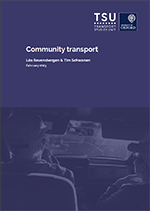When Communities Respond to a Local Need: The Case of Community Transport

Across the United Kingdom, thousands of people, most of whom are older, isolated and/or have a disability, rely on community transport to make essential trips. These not-for-profit and primarily volunteer-run schemes help those with few other options get to health appointments, to go grocery shopping, or to meet with friends - all the while building community. A new policy briefing from the Transport Studies Unit explores this under-studied transport sector, focusing on what services it offers, why it exists, and the challenges it faces.
Drawing on qualitative fieldwork, the report finds that community transport not only provides affordable, functionally accessible, and flexible transport, but can also be a tool to prevent social isolation.
These schemes are created when community members take it upon themselves to fill a 'gap' left by funding cuts to rural bus services or NHS patient transport. As rural communities have become increasingly car dependent through cuts to bus services and increased suburban development, community transport has also emerged as a car-based solution for community members who do not have access to a car.
Key challenges faced by the sector are also explored, the primary one being recruiting sufficient drivers to meet communities' needs.
Find out more about this sector, the challenges it faces, and how it can be support in the full report: Community Transport (PDF 2.4MB)
When Communities Respond to a Local Need: The Case of Community Transport
Across the United Kingdom, thousands of people, most of whom are older, isolated and/or have a disability, rely on community transport to make essential trips. These not-for-profit and primarily volunteer-run schemes help those with few other options get to health appointments, to go grocery shopping, or to meet with friends - all the while building community. A new policy briefing from the Transport Studies Unit explores this under-studied transport sector, focusing on what services it offers, why it exists, and the challenges it faces.

